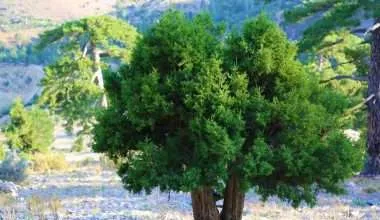Table of Contents Show
Coconuts are almost synonymous with the idea of tropical beaches, vacations, picnics, magical getaways to tropical islands and summer. Think of a picnic on a tropical beach, and included in the picture will be a coconut… growing on its coconut palm of course!
If you’ve ever heard the expression “Some like it hot,” it surely applies to the preferred habitat of a coconut palm. This towering, majestic palm will not thrive in cold-weather locations.
Coconut trees, a symbol of beachy paradises across the world, also thrive in frost-free sections of the United States. So if you reside in one of these places, you may cultivate your own source of fresh coconuts, aka your own coconut palm tree.
Where do coconuts grow?
This being summer, coconuts are the one thing that you most definitely need to have if you are going to the beach. Say, have you ever wondered where these wonderful, and amazing coconuts grow?
Coconut palms grow in tropical climates, so regions which fall in the 25 degrees Northern latitude or 25 degrees Southern altitude, are perfect for the coconut palm to thrive in.
This would include places like the Caribbean and the Pacific Islands, Australia, INdonesia or even Florida. The following list includes 9 other places where the coconut palm can grow very easily in its natural habitat.
1. Florida

Coconuts usually are only able to naturally grow in 2 states in the US. One of these states being Florida.
Although coconut palms may not survive in arid settings, they do thrive along coastal locations where circumstances are mild and cold temperatures do not occur often. Being salt tolerant, the coconut palm trees can grow in salty environments such as oceans and brackish waterways.
Although certain desert places may be continuously warm enough to be suitable for a coconut tree to grow, the conditions are usually too dry to promote healthy growth of the tree.
It is precisely for this reason that the coconut palms are not found inland even in suitable places like Florida. All the naturally grown coconut trees are near the shore.
There the trees are able to get ample amounts of water by being close to the ocean. Any tree that is found inlands is a result of human involvement.
Of course this doesn’t mean that you can’t grow a coconut tree if you don’t live in a beach house. All you have to do is get a seed and plant it, ensuring that the growing seedling gets plenty of water.
Three to six months of patient watering and caring should let you see your very own coconut seedling sprout out!
2. Hawaii

Hawaii is quite a remarkable place in the United States. Even though it is a part of the States, the interesting fact about Hawaii remains its vastly unique culture.
The entire island has a deep-rooted culture that is radically different from other mainland states. So much so that it almost feels as though Hawaii and its inhabitants are from another continent altogether!
Coconut palm trees may now be found on all eight Hawaiian islands: Ni’ihau, Kaua’i, O’ahu, Moloka’i, Lana’i, Maui, Kaho’olawe, and Hawai’i. They may also be found on Kauo, an uninhabited island in the region.
Some of these palm trees found in the various islands of Hawaii are historically relevant. Many of these ancient trees were planted to provide shade for the fish ponds that belonged to local rulers or tribal chiefs.
Thanks to the amount of plantation though, some historic groves, such as the Kapuaiwa Coconut Grove, are off-limits to visitors owing to the risks of falling coconuts!
Pop culture has bred a belief in most of us that coconut palm trees are inherently linked to Hawaii. However, that isn’t exactly the case.
While Hawaii is filled with coconut trees, the palm trees were brought in by Polynesian inhabitants. So despite what the status quo is, the coconut palm trees are not indigenous to Hawaii.
For initial settlers the coconut palm trees were very beneficial. The trees provided the settlers with an abundance of raw materials. It was not uncommon for the initial settlers to make use of every part of the palm trees.
They used the coconut trees to make buttons, fabric, ropes, brooms, musical instruments, and even roofing material.
3. Africa: The Congo River Shore

Africa, that land of the warm sun… You do know it’s not exactly a desert land but in fact Africa is a huge continent with various different regions in it. Some of these regions are deserts, others even include some of the largest tropical rainforests in the world.
It is in these tropical rainforests that coconut palm trees can be found. Most of these tropical regions fall around the great Congo river that runs across. In the warmer areas around the congo river, coconut palm trees are very common.
Since Africa falls near the equator, its moderate to warm climate is perfect for the coconut trees to flourish. The tropical coasts of Africa provide the perfect climate and water for the coconut palms to grow and spread.
4. Africa: The West Coast

The coconut palms in Africa are not native to the land. The coconuts were introduced to this region by traders and colonists.
Coconuts were usually carried for their high water content and were used as a means to obtain fresh drinkable water on long sea journeys. Usually it is the young green coconuts that contain the highest water content.
As the coconut matures the water content decreases. It is therefore probable that some overripe coconuts may have been tossed over ships which floated and eventually germinated on the shores of Africa.
5. Africa: The East Coast

The theory discussed earlier here is a highly likely account of how coconuts ended up in the remote region. Coconuts do after all have the resilient ability to be able to germinate even after floating on the ocean for weeks.
While coconut palm trees can be found in the East and West coastal regions of Africa, they are rarely spotted in the Northern or Southern areas. This is because these regions fall slightly out of the preferred latitude zones for coconut palm trees.
However, some coconut trees may be found as far north as Egypt and Tunisia and as far south as South Africa’s southern tip.
Asia

Asia is a vast continent, yet most of it is inhospitable to our beloved coconut palm tree. Any country North of Pakistan and China is simply too cold for the coconut tree to thrive.
Despite this, Asia accounts for more than 80% of worldwide coconut output, according to statistics released by Duke University. The largest coconut producers are Indonesia, Philippines and India; ranked in that particular order.
Following them is Sri Lanka which is geographically located just below India. The Sri Lankan region has the perfect climate zone for the coconut palm trees to grow.
It is also likely that certain coastal parts of other Asian countries would have coconut trees. These may include areas of Bangladesh, Myanmar, and Malaysia. Coconut palm trees flourish throughout the eastern coast of Asia, from Vietnam to eastern China, up to around Quanzhou. They are also found on the island of Taiwan.
6. Indonesia

The world’s largest producer of coconuts, Indonesia alone produces 2.85 million tons of this superfood. Most of the coconut is produced in the Riau and North Sulawesi provinces.
The warm, humid environment in these regions is perfect for making the coconut trees grow happy. Over 90% of the coconut plantations are run by small shareholders, most of whom work just 1.5 hectares of land each.
The main coconut products used here are copra or dried coconut kernels and coconut oil.
7. Philippines

In spite of being the world’s second-largest producer of coconuts, the Philippines was not a natural habitat for the coconut palm. Despite that however, the coconut palm is known as the ‘Tree of Life’ in this country, and provides an income source for a third of the country’s population.
The Davao Region is the most popular area for coconut farming. With average temperatures of over 91 degrees Fahrenheit and high humidity levels, the climate is just perfect for growing coconuts. In fact, Davao produces over 14% of the country’s coconut crop.
8. India

One of the most important crops for the agrarian economy of India is coconuts. Coconuts are grown in many areas and states across India including Kerala, Tamil Nadu, Karnataka, Andhra Pradesh, Goa, West Bengal and the Islands of Lakshadweep.
Not only is copra and oil produced from the coconuts harvested here, but the fiber present in the coconut husk supports an impressive coir industry. Green, tender nuts are also used as a healthy source of potable, coconut water, and are very popular in India.
Another popular coconut product is coconut milk, which is often used in cuisines in India.
9. Australia

Australia has a lot going on, including terrifying spiders, snakes, and sharks. Fortunately, something less frightening grows on the island of New Guinea: tree, coconut trees at that!
Papua New Guinea is located in the northwestern Pacific Ocean, north of Australia. The island is practically divided in two, with Indonesia owning the western half and Australia owning the eastern half.
Coconut palm trees line the whole island’s beaches and may also be found inland, since Papua New Guinea is the world’s seventh largest producer of coconuts!
Papua New Guinea, located just below the equator, provides ideal conditions for coconut palms, including year-round warmth, humidity, and lots of rainfall.
10. Mexico and Central America

Mexico and the entirety of Central America have the perfect conditions to promote healthy coconut tree growth. That is why it is not at all surprising that these trees are almost riddled over the entire area.
While the trees are not native to either of the regions, they still grow efficiently in the region. Researchers believe that Mexico was introduced to coconuts by settlers in the colonial periods. The travelers came from the Philippines and brought along coconuts to the west coast of Mexico.
This is probably the reason why the coconut palm trees are significantly more common in the West Coast of Mexico. There;s still plenty of palm trees in the East coast as well but just not as many as the West.
Central American nations include Belize, Guatemala, El Salvador, Honduras, Nicaragua, Costa Rica, and Panama.
Coconut palm palms are widespread across Central America. The warm, humid tropical atmosphere is ideal for the growth of coconut trees.
11. South America

While South America is not particularly famous for producing coconuts, it still does produce a significant portion of the world’s demand. Most countries in South America do tend to be too cold for coconuts despite having a rather moderate temperature all year long such as; Argentina and Uruguay.
South America’s coconut palm trees are mostly found along the North-Western, Northern, and Eastern coastal regions. Countries in these regions have a nice warm, tropical climate that is ideal for tropical these trees.
This is because the equator runs through the top strip of South America. Therefore, all the countries that fall in this region have the ideal climatic and environmental conditions to promote the growth of coconut trees.
12. Europe

Having Europe may feel unjustified, given how cold the climate generally is in the region, but then again, that is cold climate for all of Europe except… the Canary Islands of Spain.
The Canary Islands, although a Spanish, and then by extension a European territory, is still closer to Africa than Europe. Located West of Africa, the Canary Islands separate Morocco from West Sahara.
While this region does not fall in the ideal climate zone for coconut palm trees to grow, the environment in the area is still tolerable for coconut trees. Ultimately, this allows for a sufficient growth of coconut trees in this region.
Tenerife is the Canary Islands’ most well-known location for coconut palms. The volcanic island has coconut palms, coastal regions, and plenty of sunny days
How to grow your own coconuts

In spite of the number of places where coconuts can grow, there are actually just two distinct coconut DNAs that exist in the world today. Coconuts, especially those growing near any water bodies, are able to break away, float (at least six months or so) to other shores, and still retain the ability to germinate and form new seedlings that will grow into healthy trees.
This was one way in which these trees spread from their native lands of Southern India and Sri Lanka to other parts of the world. Then again, coconuts can provide food, potable water, charcoal, material for rope and a flotation device. Besides, they are majestic trees to look at!
All of this made coconuts into a superfood that pioneers, back in the ancient times, always used when they were going from one place to another. It is also the second way in which coconuts spread across the Tropics.
If you are planning on growing your own coconut, there is no reason why you can’t try! Do remember however, that the trees need a warm and humid climate so grow your coconut accordingly.
Here is what you need to watch out for:
- Temperature
Coconut seeds need a temperature of between 80 to 95 ℉ to grow. If the temperature drops between 72℉ at any time, then the growth of the plant will be impacted.
- Soil
Since coconuts often grow on beaches, fresh water is not a requirement to grow these palm trees in. The coconut palm needs soil with a pH of 5.0 and 8.0 to thrive in. The soil must also drain well so that coconut plant can grow well.
- Sun
Coconuts need a hot climate to grow in so choose the sunniest place you can find. Avoided all shaded spots.
- Timing
Planting during warm months, or during times when the climate is wet, or it is the rainy season, is the best. However, coconut plants are perennial and can grow all year round.
- Rainfall
Coconut trees grow best in areas where at least 30-50 inches of rainfall occurs every year. So make sure that your trees have plenty of water to grow.
Given the conditions it requires, the coconut palm cannot just be grown everywhere. However, there are plenty of other palm trees that you could grow. Check out which ones will grow best in your backyard!






